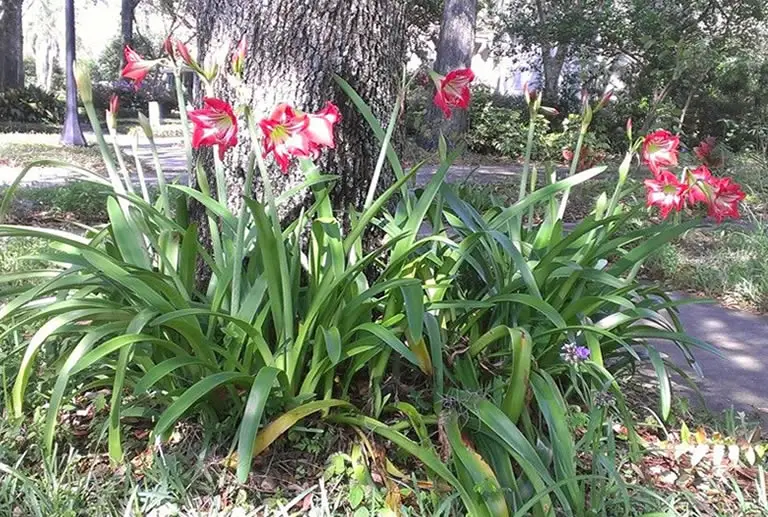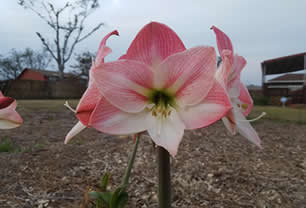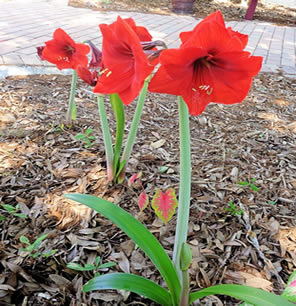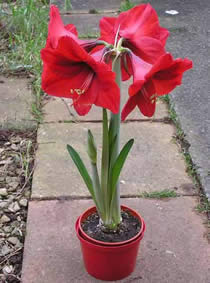The Ultimate Guide To Growing & Taking Amaryllis Outside

Amaryllis is a very popular indoor houseplant as it is an easy-care succulent that requires very little attention. But, using amaryllis outdoors is a much more challenging proposition. So, in this article I outline the challenges that gardeners encounter when they attempt to grow amaryllis outdoors as a yard plant, and I also cover the challenges involved when you want to move a potted amaryllis houseplant outdoors.
Let’s begin.
Table of Contents
Amaryllis care outdoors
Amaryllis are tropical, and subtropical, succulents and so this plant loves plenty of sunlight and warm temperatures.
As most homes are kept at a pleasant warm temperature, in both winter and summer, this makes it an excellent indoor houseplant.
But, can amaryllis be used outside?
Amaryllis can be grown outside directly in the garden in climate zones 9 through 11 and also in zone 8 but only if it is given winter protection.
Potted amaryllis can be brought outside in the warmer months in most climate zones.
But in most zones amaryllis should be brought indoors in the colder months.
Amaryllis is a tropical perennial that grows naturally in South Africa. As a tropical plant it likes warm temperatures and plenty of sunlight.
Technically speaking Amaryllis only has only 2 species though there are 1600 different species in the tropical and subtropical Amaryllidaceae plant family to which Amaryllis belongs.
Why is this worth mentioning?
Often species of Amaryllidaceae, especially those that grow naturally in the tropical areas of South America, are referred to as amaryllis and it is possible you could be growing, or could own, one of those particular species.
You should not be concerned about this however.
It doesn’t really matter which specific amaryllis plant you have as all species of this genus require the same care and react similarly in the same conditions.
Amaryllis temperature guide
So what temperatures do amaryllis grow best in?
Amaryllis will grow best in temperatures between 70° and 90°F.
Both day and night temperatures should fall between these values to encourage healthy plant growth and colorful blooms.
This temperature range is applicable to both indoor and outdoor amaryllis.
Amaryllis is a tropical and subtropical plant that likes the heat and the sun.

So, amaryllis obviously grows best in tropical and subtropical temperatures.
But this does not mean you cannot use these lovely succulents if you do not live in a tropical or subtropical climate zone.
Amaryllis temperature tolerances
So what are the best temperatures for growing amaryllis and what temperatures can amaryllis tolerate?
Amaryllis can tolerate temperatures above 60°F. It cannot tolerate freezing temperatures.
The plant will grow best in temperatures between 70° and 90°F.
Extremely high temperatures and strong sunlight can lead to leaf scorching so in those conditions keeping amaryllis in shade or partial shade is advised.
Keeping amaryllis in conditions with temperatures below 60° is not advised.
As you can see amaryllis is a fairly resilient plant as far as high temperatures go.
As a tropical and subtropical plant is can tolerate lots of direct sunlight but will also grow well in shade or partial shaded.
Although the plant loves plenty of sunlight, too much strong direct sunlight in very warm temperatures, above 90°, can lead to a yellowing of the leaves and/or leaf scorching.
So in areas that have very high temperatures, and that get strong UV rays, keeping amaryllis is shade or partial shade is the wisest course of action.
Having said that, a lack of heat and sunlight can lead to amaryllis leaves drooping and falling over.
So although you can put the plant in shade be sure it is not in a dark or gloomy environment. Amaryllis needs warm sunlight.
A guide to planting amaryllis outside as a yard plant
Most amaryllis owners will be reading this article to get information on moving their potted amaryllis houseplant outside but some of you will want to plant this beautiful succulent directly into the garden soil.
I will cover moving potted indoor amaryllis outside later in the article but first I wanted to cover the subject of growing amaryllis directly in the garden.
How to cultivate amaryllis outside so the plant thrives
Planting amaryllis outside is a very easy process.
However, you must ensure that you are planting this succulent in the correct climate zone if you want to keep it in the garden all year round.
Amaryllis can be planted outside and left there all year round in climate zones 9 through 11.
It can also be planted outside and left there all year round in zone 8, though it will require winter protection as temperatures plummet below the recommended range for this succulent.
In most climate zones, that have summer temperatures above 60°, it is possible to replant a potted amaryllis in the garden during the warm months. This is only advisable though as long as you remove it from the garden and place it back into a pot for indoor use before winter comes.
As I already mentioned too much strong direct sunlight in very warm areas can lead to scorching on amaryllis leaves and so planting the succulent in shade is a better idea than leaving it to grow in constant direct sunlight in very hot areas.
However, be aware that too much shade can lead to limited flowering or even a lack of blooms.
So give some thought, about how much sunlight the area you indeed to place the plant in gets, before you actually plant you amaryllis.
Replanting amaryllis which is displaying signs of leaf scorching into an area with full shade is often the preferred action taken by gardeners.
While initial planting in partial shade is something gardeners will do if they live in very hot areas in order to prevent leaf scorching from happening.
In most cases though amaryllis will happily grow and bloom in direct sunlight.
You should read the care guide article on amaryllis leaves to understand what the plant is telling you through its foliage. Then you can determine the best course of action to take if your outdoor amaryllis is not growing the way you expect it to.
How to plant an amaryllis bulb outside
Although it is possible to grow amaryllis in water, grow it from seed or grow it from cuttings, most people grow it from bulb.
Growing amaryllis from bulb is a very straightforward and easy process. Let’s look at how to do that now.
Soil requirements for growing amaryllis outside from bulb
Amaryllis will grow well in slightly acidic soil with a pH value of 6.0 to 6.5.
Organic soil with plenty of nutrients is best for growing amaryllis.
Adding peat or organic matter to your garden soil, or mixing in some Miracle-Gro potting mix or similarly organically-rich soil, will give your amaryllis bulb all the nutrients it needs to get started.

Amaryllis requires soil that drains well. This is essential if you want to avoid root rot or the development of fungal infections.
Although the bulb requires regular watering until it develops stalks, and an adult plant will grow best in moist soil, amaryllis does not like to sit in waterlogged soil.
Therefore the soil must have adequate drainage.
You can help with drainage by creating raised beds for your amaryllis.
Choosing the best outdoor location for your amaryllis
It is often best to pick a location that is sheltered from the wind as strong winds can easily damage newly forming stalks.
Direct sunlight is absolutely fine for amaryllis unless you live in very hot areas with strong UV rays, which could lead to leaf scorching when the bulb produces stalks.
In most areas that are suitable for growing amaryllis it will be fine to place your plant in direct sunlight. Though, if you are concerned you can place it in partial shade where it will happily grow or full shade if you live in an extremely hot area that experiences strong UV rays.
You should aim to plant your amaryllis bulb when it is in its dormant phase. This is usually in the spring or fall.
However, if your area experiences freezing temperatures at night during these times then you will need to plant the bulb in a pot indoors first. Only replant it outside when the temperatures rise.
Plant the bulb in the soil neck-deep only.
Do not cover the bulb completely but leave about a third of it uncovered.
The round part of the bulb is planted downwards with the pointed end being above soil level.
This is where the foliage will directly grow from.
If you are replanting the bulb from a pot into the garden then foliage may already be evident and you should ensure you do not cover this with soil.
Amaryllis plants will grow well when they are crowded. So, when planting more than one bulb plant them about 12 -15 inches apart.
Staggering the placement and the grouping of the bulbs, and using odd-numbered groupings, can often lead to the best overall look when the amaryllis plants start to flower. This simultaneously allows the plants ample room and space for their blooms.
Once the amaryllis bulb has been planted you can add about an inch of mulch around its base.
Do not cover the bulb completely with the mulch. About an inch is fine.
Mulch can help retain moisture in the soil while also restricting the growth of weeds and deterring garden pests.
Fully grown outdoor amaryllis plants require less attention when it comes to watering than indoor plants.
Outdoor amaryllis can can survive perfectly well on rainwater, unless of course you live in a very rain-sparse area where you will need to water the plant yourself.

Fully grown amaryllis, like all succulents, are drought-resistant plants but you should never allow the soil to dry completely.
During the growth stage of the plant you can allow the top layer of soil to dry out to a depth of about 2cms before watering is required.
Once the bulb produces stalks you can be less strict in your watering routine.
If you have not mixed-in a potting soil with your garden soil at the time of planting then you can apply a well-balanced, slow-release fertilizer at this point.
If you did use a potting mix then adding fertilize at this stage is unnecessary.
Proper fertilization methods for an outdoor bulb or growing plant
As the amaryllis enters each blooming stage, in each successive blooming season, you will want to add some fertilizer to the soil of the plant to maintain healthy levels of nutrients in the soil.
The best fertilizer for outdoor amaryllis is one with either a 10-10-10 ratio of NPK (nitrogen, phosphorus, potassium), like these, as this type of fertilizer will give amaryllis everything it needs to thrive.
However, any one of the good quality slow release succulent fertilizers will work well with amaryllis if you are growing other succulents in your garden and don’t want to use a different fertilizer for each plant.
A word of caution: do not add fertilizer after the plant has finished blooming as you will prevent the bulb from entering a phase of dormancy.
Although this can sometimes make an amaryllis rebloom, stopping the bulb from entering dormancy prevents it from resting and accumulating resources for its next growth stage.
This will lead to an unhealthy plant with faded foliage and lack luster blooms or one that never blooms at all.
Moving potted amaryllis outside
Having covered the subject of garden planted amaryllis it’s time to talk about using household potted amaryllis outside.
Many amaryllis owners want to move their potted plants outdoors in the summer months.
Moving the plant outdoors offers both a pleasing atheistic affect to the yard and also gives the plant better access to natural resources like rainwater and sunlight.
When amaryllis can survive outside and when it can’t
If you’d like to move your amaryllis houseplant outside but are unsure if this is a good thing to do then this section is for you.
Let’s, start by asking the question, will your potted amaryllis houseplant survive if you move it outside?
Amaryllis will survive outside year-round only in climate zones 9 through 11.
In zone 8 it can be left outside year-round only if it is given winter protection.
In other climate zones the plant will survive and grow well outside in the warm summer months but must be moved indoors in the colder months.
Amaryllis is a succulent that loves warm sunlight.
Growing naturally in tropical and subtropical regions means this plant does not react well to cold weather.
Freezing temperatures will kill an amaryllis plant.

You can only move amaryllis outside when the weather is warm and above 60°.
In cold climate zones it is best to keep amaryllis indoors regardless of the season.
When you should put your potted amaryllis outside
So now you now in what conditions, and areas, an amaryllis plant will survive in when outdoors you probably want to know when is the best time to move it outside?
You can move your amaryllis outside when temperatures go above 60° as long as the night temperatures do not plummet to freezing levels.
This means, that for most people, the best time to move amaryllis outside is in the summer.
Amaryllis is a tropical plant that likes heat and sunlight so summer days are best for moving the plant outside.
Think before you leave your potted amaryllis outside in winter
Moving potted amaryllis outside in the summer can give the plant a great boost but as winter sets in it may not be the option to leave your plant outdoors. Can amaryllis stay outside in winter?
Amaryllis will not survive outside in winter in most US locations.
However, amaryllis can stay outside in the winter in climate zones 9 through 11.
Amaryllis in zone 8 can stay outside but only with winter protection, if the plant is potted then it is best to bring it indoors.
Amaryllis in all other climate zones should be brought indoors during the winter.
In USDA climate zones 9 through 11 your amaryllis plant can stay outside all year round.
Although amaryllis can stay outdoors in climate zone 8 it will require protection from freezing temperatures.
In zone 8 it is common for frost in early spring and freezing temperatures in winter and these will kill your plant if you do not take appropriate steps to protect it.
As a tropical and subtropical plant amaryllis can not tolerate freezing temperatures.
So be sure to protect amaryllis is zone 8 using winter gardening techniques, like those I mention in this article, during the winter and in the early spring.
In colder climate zones amaryllis should be brought indoors for the winter and not left outside in winter.
Thanks for reading! I'm Michael — houseplant fanatic and your Pinterest plant guide.
Follow me on Pinterest for fresh updates 🌿



